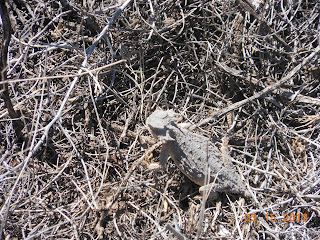During the colonial times, the area known as New Mexico was tied to the outside world by a trail through the Rio Grande Valley from Santa Fe to Mexico City about 1,500 miles to the south. The El Camino Real International Heritage Center honors this trail. The Heritage Center is near the northern end of the most deadly section of the trail - the 90 miles from Radium Springs (near Las Cruces) to Truth or Consequences. This unforgiving desert earned the name of Jornada del Muerto, the Dead Man's Journey and claimed the lives of many.
Whatever direction you viewed from the outside picnic area, you can imagine the challenges and trials of the people that have traversed the region for thousands of years. Remnants of the original trail lie just beyond the Rio Grande, east of the Heritage Center. The physical corridor was originally a trade route traveled for thousands of years by native populations of North America and Mexico. In the 1500's, the Spaniards arrived and traveled it as they ventured north renaming it "El Camino Real de Tierra Adentro" - the Royal Road to the Interior.
A cultural exchange began by those traveling the "Royal Road of the Interior" who shared ideas, customs and language between the American Indians, Spaniards, Mexicans, New Mexicans and Americans. Items that were exchanged were many. North Americans traded slaves, salt, hides, peyote, minerals, pigments and turquoise. Mexican sent exotic feathers, live macaws, copper bells and shells to adorn tribal ceremonial dress. The displays of the Heritage Center just piqued our imaginations about the long, long history of this famous, well-used trail.
Fort Craig is one of the largest forts in the west. It played a crucial role in both Indian campaigns and the Civil War. Its primary function was to control Indian raiding and to protect the central portion of the El Camino Real. The surrounding valley prospered under military protection. The fort was permanently abandoned in 1885. It is managed by the Bureau of Land Management and is listed on the National Register of Historic Places. The visitor center was a nice introduction to the history and layout of Ft. Craig (and the hosts were especially helpful).
The walking tour of the fort was very, very good. Many ruins still remain of this massive fort.
The fort had a part in many phases of New Mexico history. The Army had spent many years at Fort Craig conducting campaigns against Native Americans when a new threat appeared - the Confederates. Following the Civil War, the Army returned its attention to the Indian Campaigns.
During this era, the First New Mexico Volunteer Infantry Regiment formed. This largely Hispanic regiment served under Colonel Kit Carson. During the Civil War, General Henry Sibley led a brigade of 2,500 Confederate troops up the Rio Grande to Fort Craig. Colonel R.S. Canby (the military governor of the New Mexico territory) moved his troops to Fort Craig with the knowledge of Sibley's movements. The Blue and the Gray clashed with both sides taking heavy casualties. At the end of the day, the Confederates held the field of battle but the Union still held Fort Craig.
Doesn't this lizard look prehistoric? He could tell us some tales of Fort Craig. Glad he held still for a picture!


























No comments:
Post a Comment